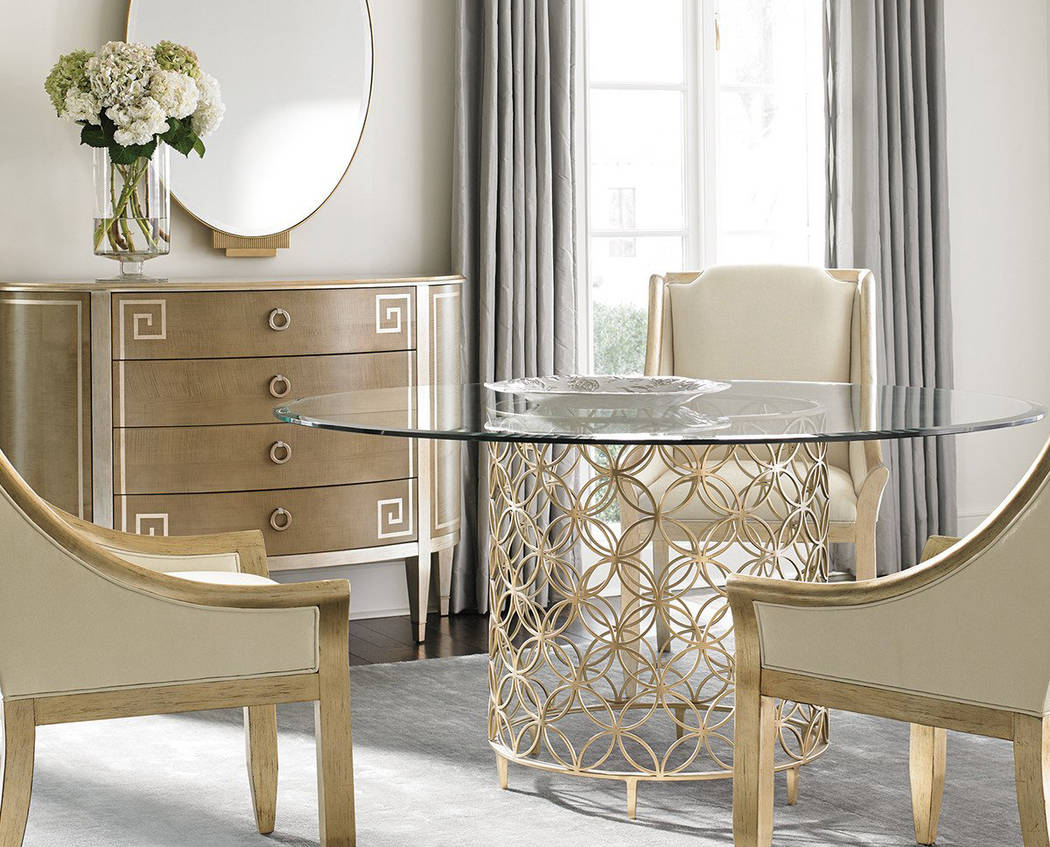All that glitters is not gold — or is it?
Recently while shopping for a client in one of our more exclusive furniture showrooms, I noticed a familiar local entertainer — famous for being one smooth and fashionable guy not only in song but in personal style, as well — purchasing two very shiny brass retro-styled lamps that certainly harkened back at least several decades.
After years of stainless steel and chrome dominating the design scene, I thought it a sure sign that we were finally swinging toward the warmer and softer shades of brass and burnished gold. I knew that for some time many manufacturers have reported a rising interest in the yellow metals, colors that were previously considered somewhat old-fashioned.
But here was a young, trendsetting man embracing the old as new again. I thought he must instinctively realize that brass is glamorous without appearing ostentatious, and I applauded his choice.
Being the holiday season, I found myself suddenly thinking back to a time of growing up in New York City when it was a family tradition during this time to visit the store windows of the world-famous department stores that lined a then-glamorous and exclusive Fifth Avenue. What a treat it was to pass those remarkable displays of silver and gold replete with familiar animated figures from the Bible and favorite Disney movies.
Even though there are now far fewer incredible Christmas window displays than during my childhood days, I still take delight in my memories of what was there, and I think that subconsciously the gaiety and beauty of the scenes must have somehow inspired my love of gold and silver leaf to this day.
Looking back, it seems as though I’ve always loved the glitz and glamour of furniture finished in leaf — be it silver or gold — as there is nothing like it for an accent piece in a room, whether traditional or contemporary. How I wish designers would have the courage to specify this type of finish more often than they do. It’s my belief that few clients, when educated about leaf and gilding and the effects that can be achieved through its use, would ever think of not incorporating some element of it, when appropriate, in their overall design plan.
After all, the craft of gold leaf gilding, in which a thin layer of metal is applied to objects for ornamentation, has been sought after and much admired for some 4,000 years after first being introduced in Northern Africa. Simply put, it’s a process whereby gold or silver foil (whether real or faux) is applied to wood in order to give the item the appearance of being made completely of either of these precious metals.
Whether I’m designing furniture or interiors, I’m always assured of an exciting and opulent look when I incorporate gilding, which invariably transforms even ordinary furniture into an extraordinary statement of style and quality.
While it’s used on picture frames, furniture and even walls, my own focus has been first and foremost on furniture pieces such as coffee tables, side tables and chairs. Nothing works better for bringing out carved details on a traditional piece or for bringing depth and allure to a smooth contemporary one.
For example, an interesting concept on my drawing board for a lady’s dressing table will feature a combination of two finishes, a rubbed back and aged (faux) silver leaf for the top along with high gloss black lacquer for the legs. A true marriage of the contemporary and the traditional. With a bit of imagination and daring, the leaf finishes are indeed quite remarkable in their adaptability to any number of design possibilities.
By this point, you must be thinking that surely such grandeur must come at an exorbitant price. But you’re wrong, for the most part. Yes, genuine gold and silver leaf is, of course, expensive (especially at today’s inflated prices), but there have been, in my experience, only very rare occasions when a client insisted upon using the real thing.
In its place, designers turn to foils or squares that are made up of a composition of metals. Imitation or faux gold leaf is derived from combining copper and zinc to form brass, while faux silver is derived from pure aluminum.
Both are very thin, 4 inches square, and generally sold in a booklet or in a roll of 25 or more sheets. The actual process of gilding itself is time-honored and rather straightforward, though certainly best left to a qualified craftsman.
Furniture that’s to be gilded (whether real or imitation) requires a primer called “bole,” which is applied first so that the leaf has something to adhere to. The bole is generally red or clay in color, which accounts for the red that can often be seen on gilded furniture as it ages or is “rubbed back” to simulate aging.
A sizing or glue is applied a few hours after the bole, and once the glue sets a sheet of gold leaf is laid over the wood and brushed into place. A sealer and top-coat are then added to keep the gold or imitation leaf from flaking and falling off.
Add a gold or silver leaf piece to your decor, and the glamour of the holiday season, whether in New York City, Las Vegas or elsewhere, can be yours all year long. All that glitters is not gold, or is it? I’ll never tell.
Stephen Leon is a licensed interior designer, certified professional in green residential design and president of Soleil Design (www.soleildezine.com). He is past president of the Central California/Nevada Chapter of the American Society of Interior Designers. Questions can be sent to soleildesign@cox.net.

















